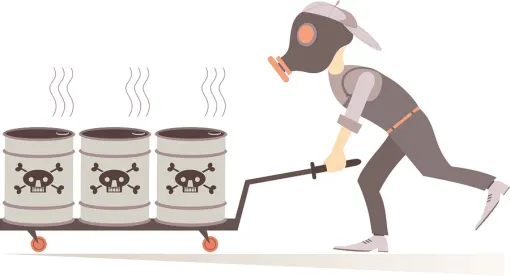On March 21, 2018, the Vermont Senate approved S.197, a bill that (1) establishes strict liability, jointly and severally, for any person who releases a toxic substance and (2) creates a private right of action for medical monitoring damages related to toxic substance exposure. The Vermont House Judiciary Committee split the bill in two after hearing extensive testimony. The strict liability provisions are now attached to an unrelated bill, S.123, while the medical monitoring provisions remain in S.197.
S.123: Strict Liability for Toxic Substance Release – Amending 10 V.S.A. ch. 159 §§ 6685-86
If adopted as currently drafted, this bill will change dramatically the way toxic substance releases are regulated and litigated in Vermont. First, the bill’s proposed new definition of “toxic substance” is sweeping. The definition includes any substance “identified as toxic or hazardous under state or federal law” as well as any substance “that has been shown at any time to cause increased risk of disease.”
Second, creating strict liability for releases would effectively invalidate environmental discharge permits provided by either the state or federal governments. The bill would expose an entity to strict liability for any release, regardless of whether the entity obtained a permit authorizing that discharge or activity.
Third, the bill proposes joint and several liability. Any company found to be liable for any part of the release would be liable for all of the damages. Companies would still be able to sue others for contribution. Fourth, the right to seek contribution under the draft bill includes the right to sue a manufacturer for failure to warn of “a toxic substance’s propensity to cause the harm complained of.” However, the bill fails to identify who the manufacturer must warn. The language only refers vaguely to warning “a person.” This hearkens to California’s long-criticized Proposition 65 and its far-reaching consequences.
In an effort to protect consumers and business interests, S.123 also calls for the Commission of Financial Regulation to monitor how the bill affects pricing and availability of insurance in Vermont. The bill proposes an effective date of July 1, 2019 for strict liability, and would apply only prospectively.
S. 197: Medical Monitoring Damages – Amending 12 V.S.A. ch. 219 §§ 7201-02
If adopted in its current form, the amendment would set a low bar for plaintiffs seeking medical monitoring damages. The amendment would allow a plaintiff “with or without a present injury or disease” to bring suit against a person who released a toxic substance. The plaintiff would have to show that (1) they were exposed as the result of tortious conduct by the defendant, (2) there is a “probable link between exposure . . . and a latent disease,” (3) the plaintiff’s exposure increases the risk of contracting the latent disease, (4) diagnostic testing is reasonably necessary, and (5) medical tests or procedures exist to detect the latent disease. As it stands, the amendment does not require the plaintiff to show a disease is even likely to occur, only that there is an increased risk. The draft bill’s proposed effective date is July 1, 2018.
The implications of these bills for entities engaged in activities related to toxic substances in Vermont, including manufacturers whose products end up in Vermont, are broad. We will continue to monitor S.123 and S.197. If passed, the bills will push Vermont-related entities to carefully analyze their compliance regimes and reconsider their appetite for toxic tort liability.



 />i
/>i
